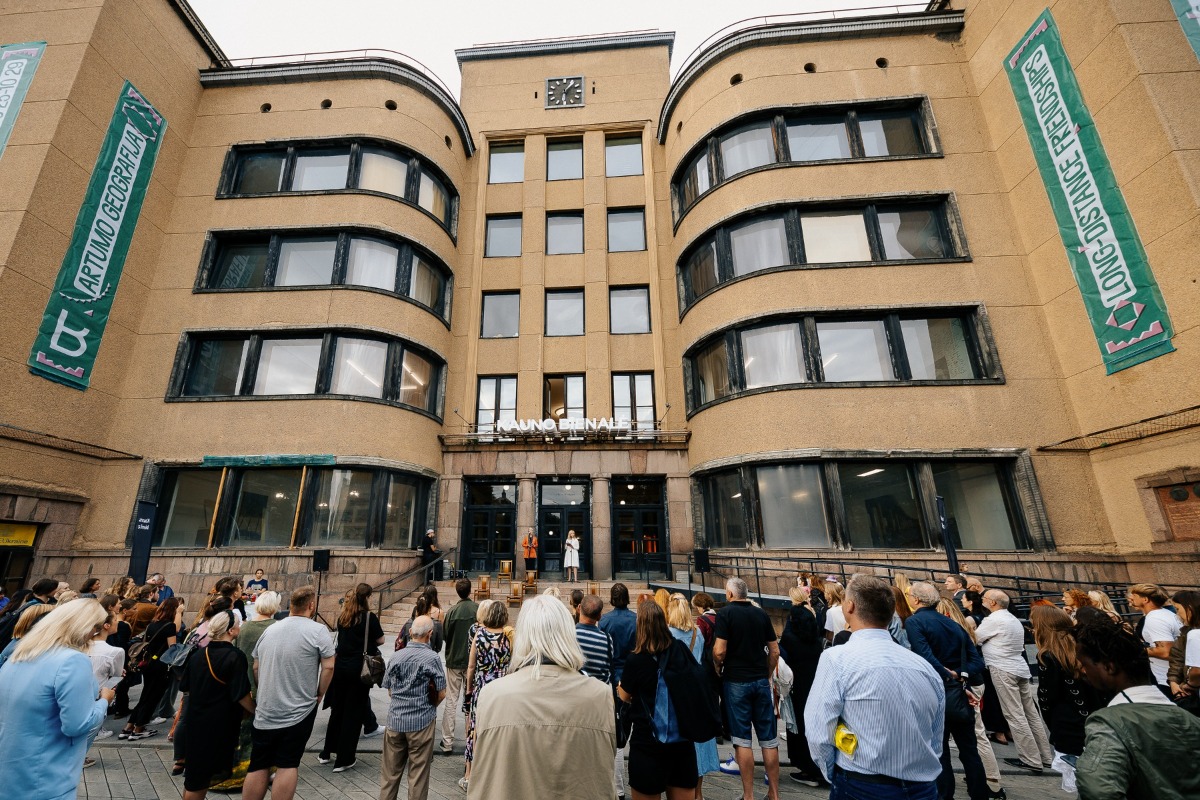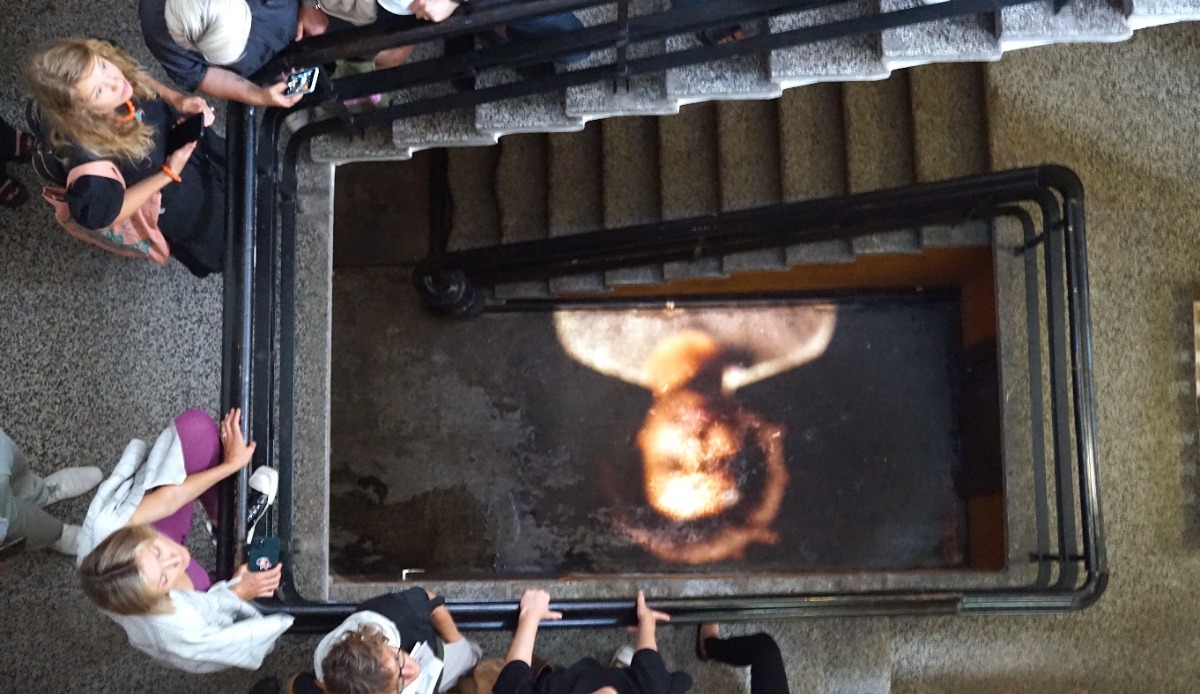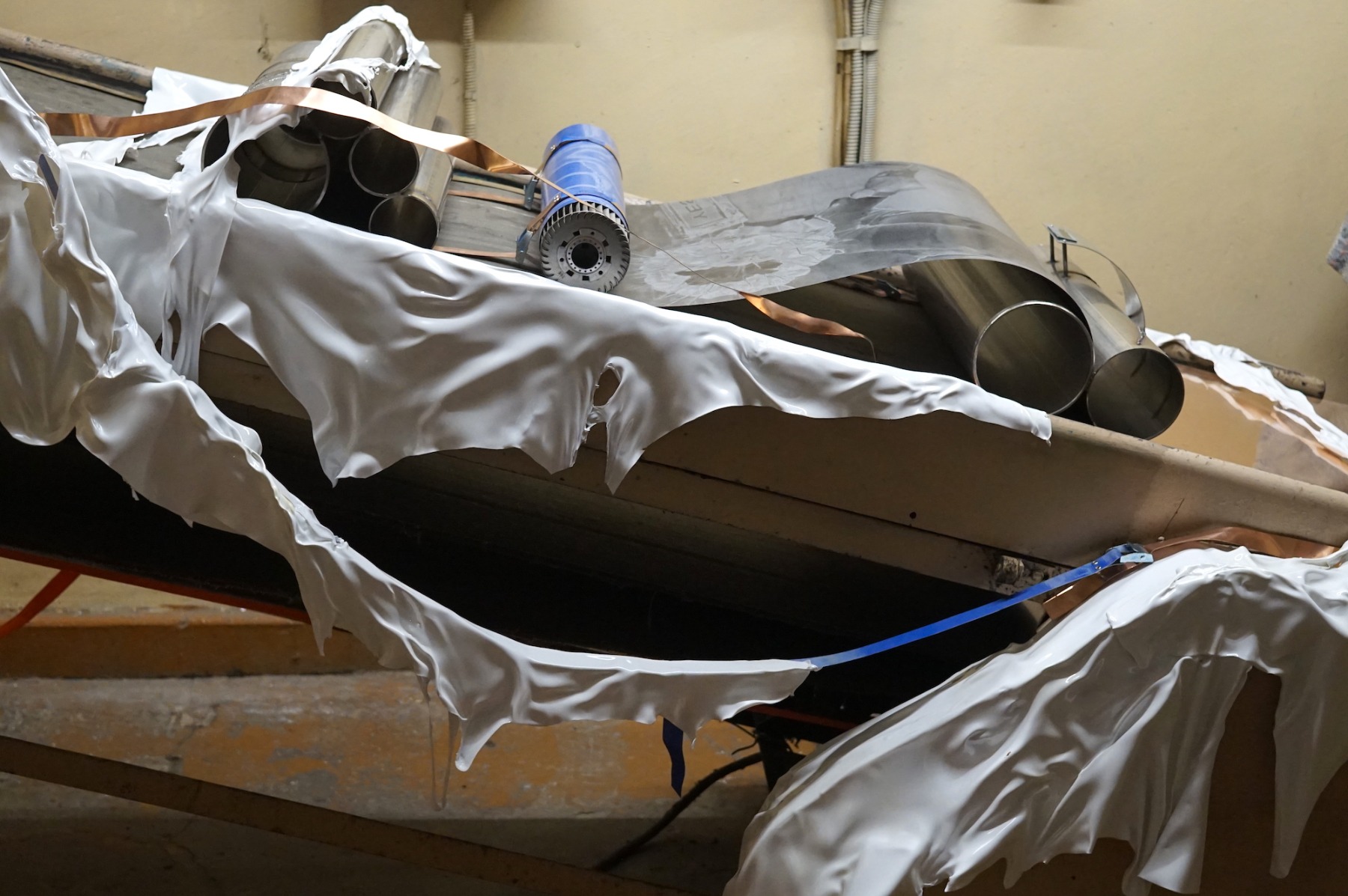
Old post-office, new friendships
On August 25th the 14th Kaunas Biennial began, the first part of the Long Distance Friendships project, making it a sister event to the 14th Survival Kit festival soon to be open in Riga.
You go to the post office to send a couple letters. You walk up the stairs and step into a spacious hall with many little booths, usually occupied by the post office workers handling the messages of others. But, what is this? Instead of the post office employees someone completely different appears in the booths – the very people have written your letter to. Distance has been eliminated, everyone is in the same here and now, where it’s possible to easily send a message to 1965. There’s a whole festivity of communication, someone is banging the drum, others are dancing. This might be the kind of dream you’ll have after visiting the main exhibition space of the Kaunas biennial which opened last Friday.
Une nouvelle région du monde by Valérie Osouf & Hamedine Kane. Photo: Arterritory.com
The catch is that Kaunas’ central post office, a renowned masterpiece of Lithuanian modernism, is that exhibition space itself. Opened in 1932, back when Kaunas was the capital of independent Lithuania at the peak of its national rise, it is located at the heart of the new city – the part of Kaunas that became a site of intense construction in the 1920-30s. Here is where people sent their mail to Poland, Germany, Norway and, at the time, still colonial Africa. This building is itself a proud monument to communication, or rather to the desire of leaving a note, or maybe even entering a dialogue.
Press conference of the 14th Kaunas Biennial in the main operating room of the post office. Alicia Knock speaking. Photo: Kaunas Biennial 
So, few better places could have been found for an exposition under the Long Distance Friendship title. Moreover, the biennial’s program and underlying concept are themselves the result of friendship and professional exchange. This begins with the friendly dyad of curators Alicia Knock (the Pompidou Center’s head of the contemporary art department, who works on expanding the museum towards African and Central European art) and Inga Lace (a curator for the Latvian Center for Contemporary Art, or LCCA, who’s participated in the New York’s MoMa research program on Central and East European art for the last few years). This time the Kaunas Biennial and LCCA’s brainchild, the yearly Survival Kit festival, which opens on September 7th, have merged their programs and concepts. A whole slew of artists exhibiting in Kaunas will present their works in Riga as well. In some cases, like with Anastasia Sosunova, the Kaunas and Riga versions of the work will provide different takes on the same theme. Around 40 artists will be exhibited during the Kaunas and Riga events. This partnership extends to one other level as well – one of the participants in Kaunas is Ibrahim Mahama (Ghana), who is also curating this year's Ljubljana Biennale (opens on September 15th). As he’s also partnered with Knock and Lace, some works, like Jaanus Samma’s (Estonia) handmade carpets (an old customary estonian wedding gift that the artist imbues with queer themes) will be exhibited in Kaunas, Riga and Ljubljana all at once.
Installation by Ibrahim Mahama. Photo: Kaunas Biennial 

This quite particular story of international cooperation is the embodiment of the themes of long distance friendship and transnational solidarity. Alicia and Inga elaborate: “This project attempts to make the history of relations between Africa and Eastern Europe more cogent, since they’re more closely tied than it’s assumed. The old central post office in Kaunas and Riga’s Vidzemes market are both collapsed spaces of unity and exchange. The history of each space reflects the histories of people who have inhabited it. Based on these personal histories, we use traces of the past to offer alternative outlooks on the future with the help of our artists. In times of geopolitical fragmentation it’s important to strive towards international alliances built on the basis of friendship and cooperation, and not power dynamics.” How close is the post-soviet experience of Baltic countries to the postcolonial experience of African states? Might European states that have never enacted colonialism, and were included in the cultural-economic exchange of the 1960-70s only as parts of the “socialist block”, turn out as more desirable partners to African countries in various types of exchange?
A performance by the international dance company Aura, produced in collaboration with the artists Yonamine and Ihosvanny Angel and dedicated to their experiences of war refugees. Photo: Kaunas Biennial

Interestingly just a few days prior to the opening of the Kaunas biennial, the former premier of Latvia Krišjānis Kariņš, who had just resigned in August, held a speech espousing similar ideas. As reported, he might be betting on an international career now: “Countries that used to be colonies don’t necessarily listen to the advice of former colonizers. We in Latvia obviously understand that.” Kariņš holds that it’s the states of the new Europe which might become more desirable partners to Asian, African and Latin American countries, or at least serve as mediators in these partnerships.
On the ground floor of the Post Office. Photo: Kaunas Biennial
So the international context of the Long Distance Friendship concept is quite relevant. However, it’s very hard to tell whether today’s art, as a field, can give birth to new forms of international relations. So far, what is at hand resembles merely a shifting of contexts. The African context comes to the Baltics for a visit, manifests itself in the local environment, reminds and tells of itself. For example, a visitor to the Kaunas post office main lobby gets transported to an African Post Office through the object-and-sound installation made by a collective of visiting artists (Sumayya Vally, Moad Musbahi, Thania Petersen, Sukanta Majumdar), while the neighbouring hall houses rows of neatly arranged post crates, ones that used to be rented for personal correspondence, decorated with postcards of Ghana's infrastructure sights, made by Ibrahim Mahama. As part of the biennial this artist has also intervened into urban space – his drawings have appeared on pieces of patterned cloth in the upper windows of a broken-down former military barrack building on Juozapavičiaus, 19.
Installation by Ibrahim Mahama in the windows of a former textile factory. Photo: Kaunas Biennial
In terms of a more deliberate merging of contexts, the most impressive work I found during the opening day was the installation by the Angolan artist Yonamine and his colleague Ihosvanny Angel, dedicated to Luanda’s artist and cultural figure Paulo Kapela. It was located at another exhibition area of the biennial – an old powder depot dug into a hill, which has recently been turned into a new Kaunas' cultural venue named P.A.R.A.K.A.S. As you enter its underground dungeons and pass a few exhibitions of other participants, you gradually approach the long hall, which was turned into an art space, lit in red and filled with candles and all kinds of other items, – here the photo of Paulo Kapela stands next to pictures of Latvian politicians who are still very much alive, and everything else that the artists could bring with themselves or, in some cases, found in Kaunas: books, figurines, flashlights, bottles, hammers, paintbrushes, masks. Yonamine marks this approach as “installational realism”. I asked the artist what guided him when arranging these combinations and the reply was: “Intuition... We found some things on the streets, others we were given as a gift – like the Lithuanian bread, for example. Kaunas is a big city, anything can be found here. These objects are related to work, like the hammers, to intellectual pursuit, like the books, etc – there's a lot of different layers, and they all talk to the viewer in their own way. We, the artists, are only the vector in this, merely intermediaries who carry the message from the objects to the viewer. The fact that all of this is situated underground as if becomes the embodiment of the formula conceived by the African musical and political leader Fela Kuti all those years ago, – Underground Spiritual Game”.
The P.A.R.A.K.A.S. Hall, hosting a joint installation by the Angolan artist Yonamine and his colleague Ihosvanny Angel, dedicated to the Luanda artist and cultural figure Paulo Kapela
Angolan artist Yonamine in an installation space at P.A.R.A.K.A.S. Photo: Kaunas Biennial


This isn't the only tribute to African cultural leaders of the past – the great teachers – that can be seen in Kaunas. In the former mail stop hall of the old post office there is a spacious work by The School of Mutants, a group of young African and French artists and film directors. It is dedicated to Ousmane Sembene, a Senegali writer and filmmaker, once titled “the father of African cinema”. He saw his mission in creating images and texts that would reach wider audiences, going beyond the framework of his time's intellectual bourgeoisie. “Sembene considered his films to be multi-language translations of his literature, approaching the writing and translation of both his scripts and novels as an ethical act of exchange and inclusivity”. His brilliant formula “I am My Own Sun” became the title for the exposition that includes wall-writing, improvised altars and monuments', – it also addresses another important theme: the possibility of education that's both accessible and geared towards local specifics, one that could pass on experience and instill hope in the future.
A fragment of an exposition by The School of Mutants and dedicated to the cultural heritage of Ousmane Sembene
Another example of a mutagenic context shift in service of creating pieces that would remain uniquely relevant in all contexts involved is the memorable work of the famous Lithuanian artist Anastasia Sosunova named Body of an Image. It is akin to an autopsy of the printing press' body, sitting directly on one of the mail stop's conveyor belts. On the one hand, it is a reference to a specific prototype – like the press of "ab", the Kaunas’ secret underground printing house operating in the 1980-90s and built from scrapped and thrown away parts of other machines. Back then that printing press was mainly used for patriotic and religious literature. On the other hand, building upon this experience of resistance, Sosunova reframes it, employing a strategy she calls extended montage, and imbuing this story with visual elements from the African underground queer press – an Ugandan periodical Bombastic (she also uses a Lithuanian 1990's gay magazine Naglis).
Fragment of Anastasia Sosunova's «Body of an Image». Photo: Arterritory.com


However, contexts can clash, contradict and ignore one another just as well. At the Same Time by the Georgian artist Andro Eradze is a good reminder. At the center of a space whose windows are covered in red film there is a wall built from screens projecting a video piece that was shot by Andro, as he invaded a foreign territory – the places inhabited by stray dogs. The dogs' stretched bodies are rushing across the frame in slow motion, illuminated by anxious red light. “Using the camera as a guide, Eradze ventures into the very heart of these creatures' domain, capturing their reactions as they defend their pack and their place. The tension between a deep seated need to belong and the instinctive desire to protect and be protected is brought to the fore”, – reads the annotation.
Visitor in the hall where Andro Eradze's work «At the Same Time» is displayed
The post office exhibition utilizes almost the whole building, using the most unexpected places – the Une nouvelle région du monde video by Valérie Osouf and Hamedine Kane is especially striking, as it's projected into the space between the floor stair flights. The footage shows the rivers Guadalupe and Niger interspersed with close shots of people's faces, the living portraits of Caribbean immigrants. Ukrainian artist Nikolai Karabinovich made good use of the phone booths of the ground floor next to the entrance – through the VEF telephones handset Georgian singing can be heard. This is an audio-quote from the movie Mimino, while the video-quote can be seen in one of the rooms on the first floor – the scene being projected there is of the main character trying to call the small Georgian village Telavi, but gets connected to Tel-Aviv. On the other end, a Georgian immigrant picks up the phone, so contact ends up established despite all communication breakdowns, – two people sing the same song together, the one we can hear in the phone booths on the first floor.
Nikolay Karabinovych,
Invisible to us Isaac, 2023. Photo: Arterritory.com

During the tour around the post office exhibition, its curators Alicia Knock and Inga Lace told me that the African artists visiting Kaunas became very interested in the tradition of sutartinės, ancient Lithuanian many-voiced songs, – the proof that we can still join together in sound, emotion and experience. This is also expressed in the droningly, hypnotically mournful work from the Lithuanian artist Andrius Harutyunyan Three to Midnight in which he, together with Anastasia Sosunova and Yonamine, use gigantic tubas, made out of scrapped instruments, to improvise some sort of musical envoy and signal. The atmosphere of the underground P.A.R.A.K.A.S. spaces fits this perfectly.
A fragment of the exposition of the Lithuanian artist Ieva Martinaitytė-Mediodia. On the wall she transferred her letters which she once sent to her mother. Photo: Kaunas Biennial
However, we're only just approaching the true long distance friendship – the understanding and respect of each other's contexts. In that sense the Kaunas biennial is an important first step, with its own successes (the initial concept of a joint statement by the two large art events, wide and elaborate range of participants and works, an incredibly fitting main venue) and lacunas (there could have been more information on the artists and their contexts, the subject warrants a whole magazine or a sizable catalogue). We'll see how this theme will grow in range and depth at Act II of Long Distance Friendships – Survival Kit festival to be opened in Riga of September 7th. The wait won't be long.
Title image: The opening of the exposition of the biennial in the building of the post office Photo: Kaunas Biennial